Perfect recessed lighting in a living room enhances both functionality and aesthetics. First, determine the room’s purpose to influence lighting choices. Create a detailed reflected ceiling plan to visualize light zones. Follow precise positioning and spacing guidelines to ensure even light distribution. Choose the right fixtures based on the ambiance desired and calculate lumens for brightness specific to various activities. Incorporate dimming and control options for flexibility, and layer different light types to achieve the perfect atmosphere. More insights await for achieving optimal results.
Key Takeaways
- Define distinct lighting zones in your living room to match the space’s functionality, enhancing both ambiance and usability.
- Ensure recessed lighting fixtures are 2-3 feet away from walls to minimize shadows and maximize even light distribution.
- Select the appropriate bulb type, such as LED for efficiency or halogen for brightness, based on your room’s needs.
- Incorporate dimmable options and smart controls for versatile lighting scenarios, allowing you to easily adjust brightness and scene settings.
- Layer different types of lighting, including ambient, task, and accent, to create a comfortable and visually appealing living space.
Determine the Function of Your Living Room
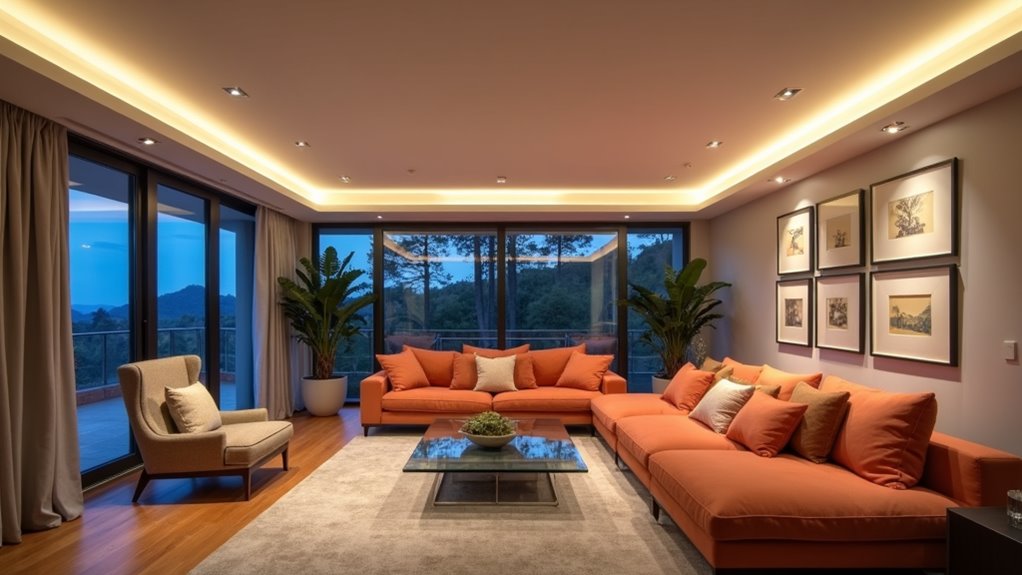
The functionality of a living room serves as the cornerstone of its design, influencing not only the choice of furniture but also the lighting arrangement. Understanding the various living room activities, from gatherings to quiet reading sessions, is essential in tailoring the lighting scheme. Ambient lighting provides a warm, inviting atmosphere for social interactions, while softer, dimmable options create a cozy retreat for relaxation. Additionally, proper lighting choices can enhance the ambiance and usability of different areas within the space. Task lighting is critical for dedicated areas, such as reading nooks or workspaces, requiring focused illumination to enhance usability. Furthermore, accent lighting can highlight unique architectural features or artwork, adding personality and depth to the space. To achieve an ideal arrangement, it is important to incorporate a layered lighting strategy that includes ambient, task, and accent elements for a well-rounded illumination experience.
Create a Reflected Ceiling Plan
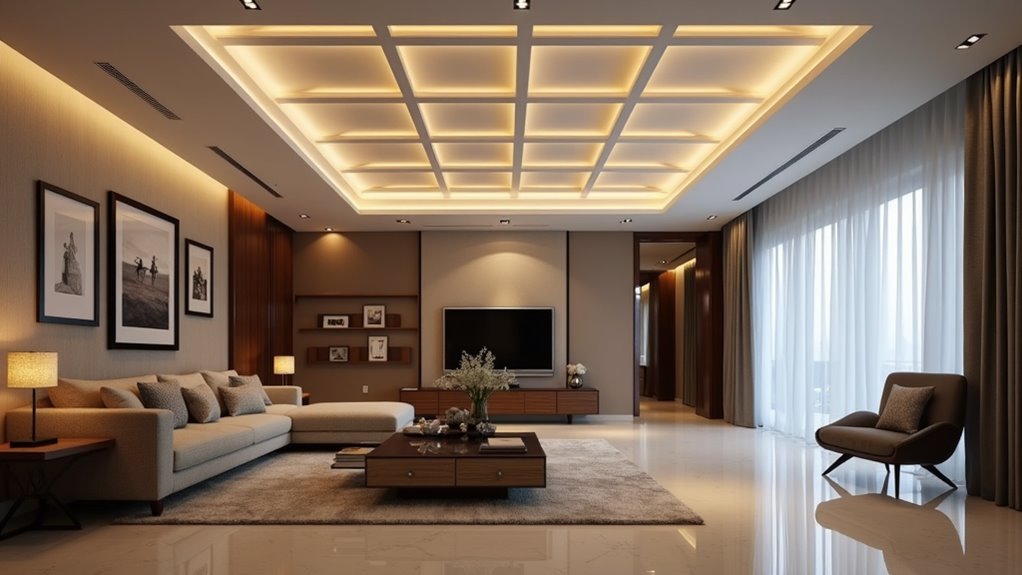
To effectively create a Reflected Ceiling Plan, it is essential to pinpoint the precise locations of recessed lighting fixtures within the living room layout.
This process also involves visualizing distinct lighting zones that align with the room’s purpose and aesthetics, ensuring illumination is evenly distributed.
Identify Fixture Locations
Creating an effective reflected ceiling plan (RCP) for recessed lighting requires meticulous attention to detail, as it serves as a blueprint for optimal fixture placement within the living room.
This plan should reflect not only fixture aesthetics but also layout strategies that enhance overall design.
- Incorporate lighting fixture symbols for clarity.
- Precisely locate fixtures, measuring distances from walls and other key elements.
- Note switching information for ease of use.
- Indicate ceiling heights and architectural features impacting lighting.
- Include other ceiling components for comprehensive coordination.
Visualize Lighting Zones
Reflecting on the accurate fixture placements identified in the previous section, visualizing lighting zones through a reflected ceiling plan (RCP) is vital for achieving a harmonious living room design.
An RCP illustrates precise lighting placement while coordinating other ceiling elements such as HVAC vents and structural features. By mapping different zones, designers can strategically position fixtures to maintain zone balance and ensure even light distribution.
This layout allows for the integration of varied lighting types—ambient, task, and accent—tailored to the room’s functions.
Moreover, it facilitates effective communication among contractors, minimizing installation errors.
Ultimately, an RCP serves as a comprehensive guide for creating a coherent lighting experience that complements the living space’s aesthetic and functionality.
Positioning and Spacing Guidelines
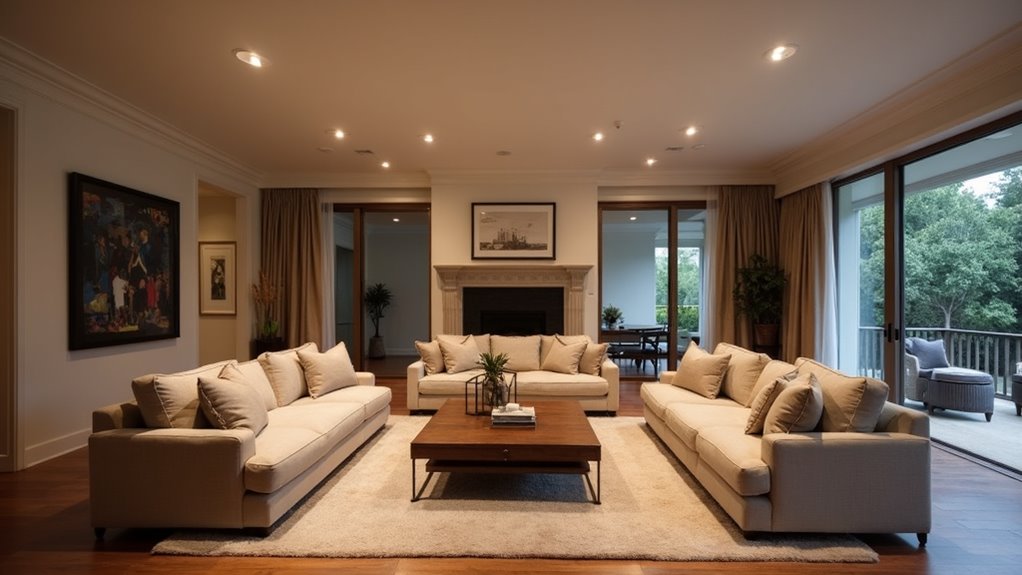
How can one master the art of positioning and spacing recessed lighting in a living room? Effective recessed light spacing is vital for both aesthetics and functionality, ensuring adequate illumination without creating unwanted shadows.
Adhering to these principles can enhance the room’s ambiance:
- Ceiling Height Rule: Divide ceiling height by two for spacing.
- Distance from Walls: Position lights 2-3 feet away to avoid scalloped shadows.
- Maintain Consistent Spacing: Keep an even distribution to prevent dark or overly bright spots.
- Avoid Overcrowding: Too many fixtures can create glare and discomfort.
- Consider Natural Light: Factor in existing light sources when planning.
Choosing the Right Fixtures
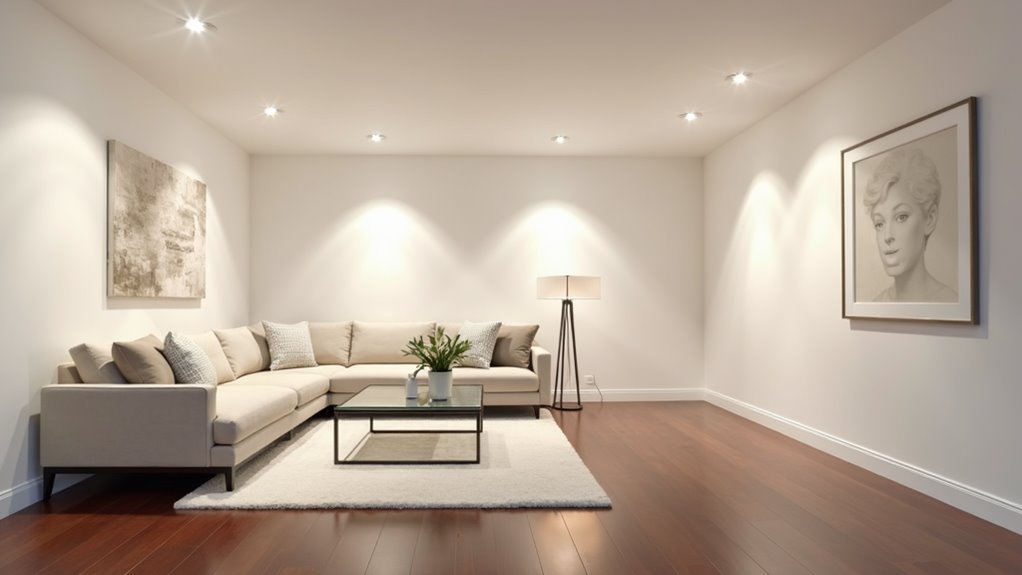
Selecting the appropriate fixtures for recessed lighting in a living room involves careful consideration of fixture types, trim styles, and energy efficiency.
Each fixture must harmonize with the room’s architecture while serving functional needs, from directing light to complementing decor.
Additionally, energy-efficient options can enhance both illumination and sustainability, making informed choices essential for achieving the perfect ambiance.
Fixture Type Selection
Choosing the right fixtures for recessed lighting can significantly enhance both the functionality and aesthetic appeal of a living room.
Selecting the appropriate type of fixture involves considering various factors:
- Housing Type: New construction or remodel housings affect installation methods.
- IC-Rated vs. Non-IC Rated: Determines safety concerning insulation contact.
- Airtight Housings: Improve energy efficiency through reduced airflow.
- Bulb Type: LED options offer longevity and energy efficiency, while halogen provides brightness.
- Aperture Size: Larger fixtures for general lighting vs. smaller for focused task or accent lighting.
Understanding fixture placement is crucial; it can vastly influence not only the illumination efficacy but also the overall aesthetic of the living space, showcasing its best features without overwhelming the design.
Trim Style Options
The allure of a well-designed living room can be amplified through careful consideration of trim style options for recessed lighting. Trim color plays a pivotal role; while white blends seamlessly into ceilings, darker hues absorb light, influencing perception.
Material choices vary from sleek metal to lightweight polyurethane, offering diverse finishes like brushed nickel and oil-rubbed bronze. Decorative styles such as baffle trims provide glare reduction with ribbed interiors, perfect for soft illumination.
For minimalistic designs, flangeless trims enable flush installations that achieve an elegant, unobtrusive appearance. Adjustable options, such as gimbal and eyeball trims, allow precise manipulation of light direction, enhancing ambiance by focusing on art or architectural features.
Making informed trim selection is crucial for optimal lighting effect.
Energy Efficiency Considerations
In the pursuit of an energy-efficient living room, the selection of recessed lighting fixtures becomes a pivotal consideration, particularly after exploring trim styles that enhance aesthetics.
Emphasizing energy savings while maximizing brightness, the right fixtures can lead to long-term benefits.
Key factors to consider include:
- Choose ENERGY STAR certified LEDs for significant energy savings.
- Understand lumens over wattage to optimize brightness with lower power usage.
- Implement dimmer switches to modulate brightness, enhancing control and efficiency.
- Select appropriate housing types, like airtight designs to minimize heat loss.
- Consider integrated LED fixtures for longevity, extending beyond 50,000 hours.
Calculating Lumens for Desired Brightness
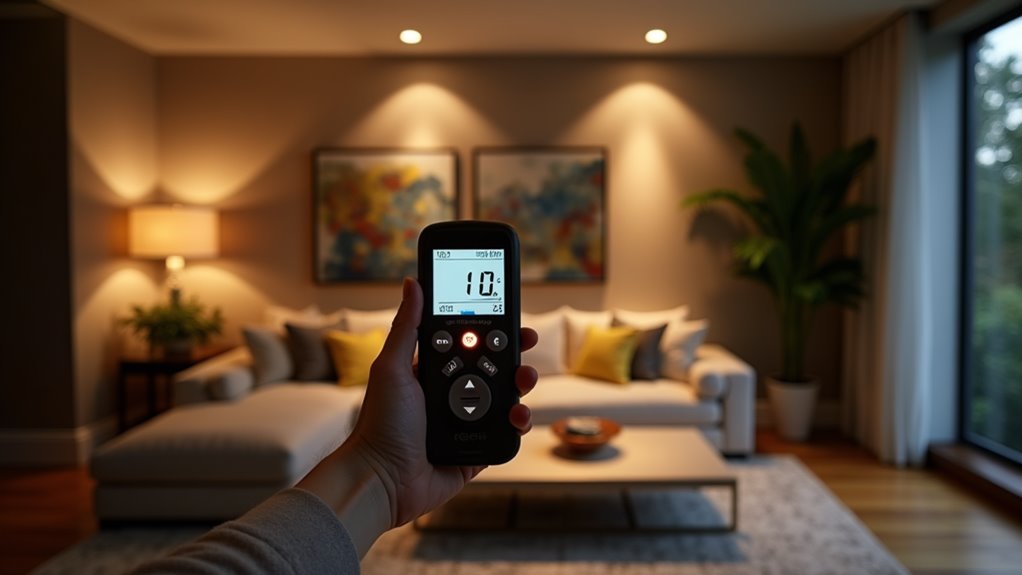
Calculating the appropriate lumens needed for a living room can significantly enhance both comfort and functionality. Lumen calculations begin by considering the room’s square footage and desired brightness levels, typically ranging from 10 to 20 foot-candles.
Calculating the right lumens for your living room enhances comfort and functionality, ensuring the perfect ambiance for any activity.
For instance, a 100 sq ft room requiring 20 foot-candles necessitates approximately 2,000 lumens. Factors such as room size, ceiling height, and color schemes greatly impact lumen requirements; darker rooms may require higher brightness levels.
Additionally, specific activities—like reading or entertaining—also dictate lumen output. Recessed lighting fixtures vary in lumen output; thus, selecting the right number of fixtures based on total lumens needed ensures even light distribution.
Mastering these calculations fosters an inviting atmosphere tailored to personal preferences.
Incorporating Dimming and Controls
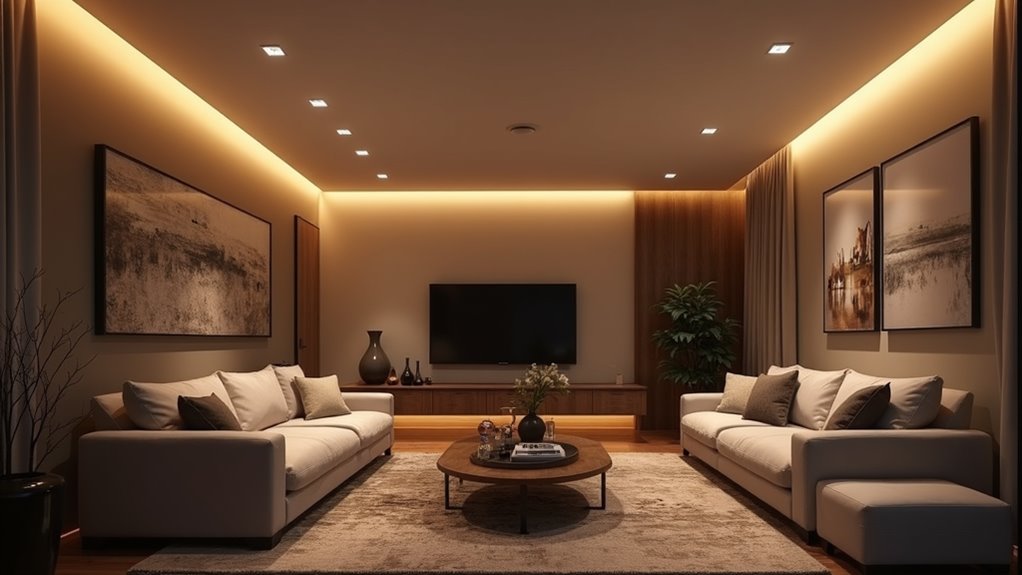
Incorporating dimming and control features into recessed lighting systems transforms the way individuals experience their living spaces.
By selecting the right dimmer types and using smart controls, homeowners can elevate functionality and ambiance effectively.
Consider these essential aspects:
- Variety of Dimmer Switches: Options include slider, tap, and rotary types.
- LED Compatibility: Use specific dimmers engineered for LED technology, minimizing flicker and noise.
- Smart Dimmers: Enable remote control via apps, Wi-Fi, or voice assistants.
- Gang Capacity: Multi-gang dimmers allow independent control for different light sets.
- Scene Programming: Customize lighting for various moods or activities.
With thoughtful integration of these features, recessed lighting becomes a versatile design element that enhances comfort and usability.
Layering Light for Optimal Ambiance
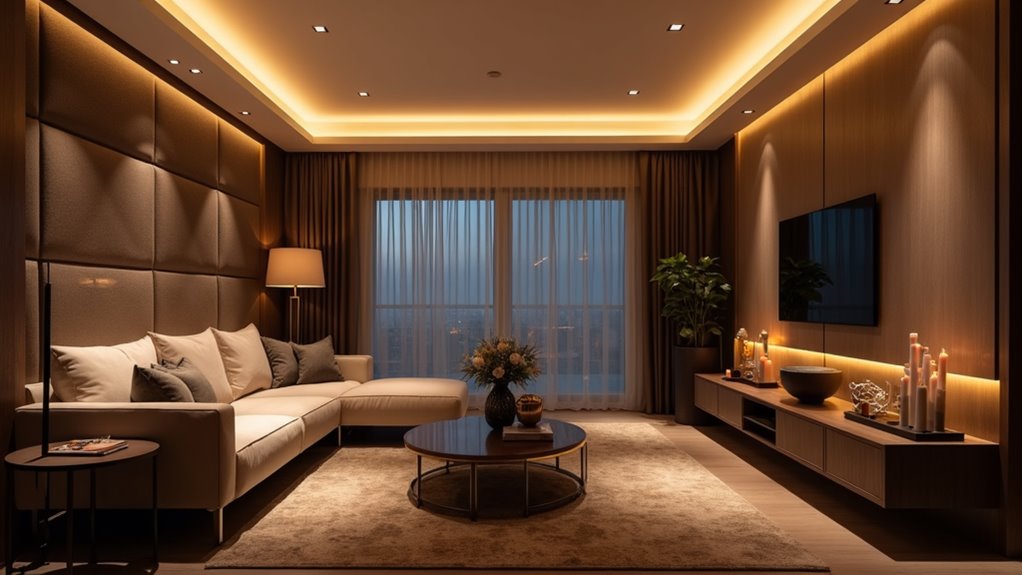
Layering light within a living room creates a harmonious interplay of illumination that enhances both function and atmosphere. By integrating ambient, task, and accent lighting, one achieves spatial depth and mood enhancement. Ambient lighting forms the foundation, offering general illumination. Task lighting then provides focused light for specific activities, while accent lighting draws attention to decorative statements, enriching visual interest.
| Lighting Type | Purpose |
|---|---|
| Ambient Lighting | General room illumination |
| Task Lighting | Focused light for activities |
| Accent Lighting | Highlight features and decor |
This strategic combination ensures versatility, allowing adjustments for different activities and overall ambiance, ultimately crafting an inviting and aesthetically appealing living space.


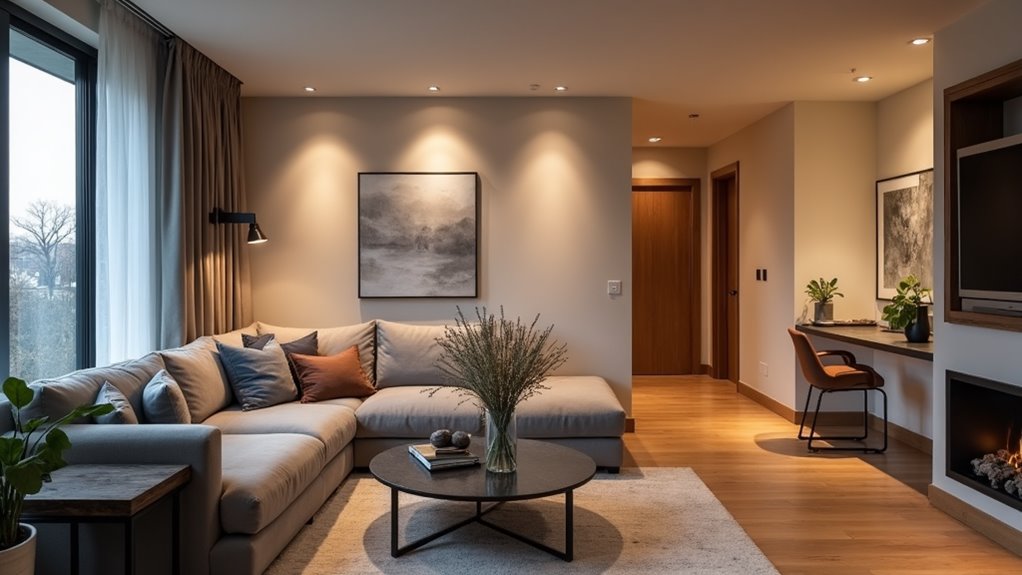
Bài viết cùng chủ đề:
10 Essential Living Room Lighting Trends for 2025
Top 5 Living Room Track Lighting Fixtures for Modern Homes
7 Tips for Creating Stunning Living Room Cove Lighting Designs
3 Brilliant Ideas for Living Room Floor Lighting
10 Brilliant Living Room Overhead Lighting Ideas
Top 5 Semi-Flush Living Room Lighting Fixtures for 2025